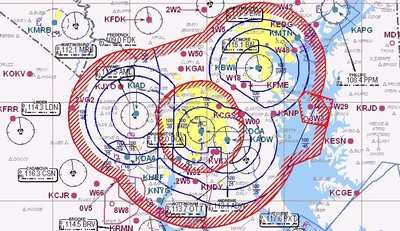Just How Effective Is It?
 The highly respected Congressional
Research Service (CRS) has raised questions concerning the
effectiveness of the Washington, DC, Air Defense Identification
Zone (ADIZ) and its effects on general aviation.
The highly respected Congressional
Research Service (CRS) has raised questions concerning the
effectiveness of the Washington, DC, Air Defense Identification
Zone (ADIZ) and its effects on general aviation.
"Detailed risk-based assessment, examining the various different
types of GA operations conducted in the [National Capital Region],
may be undertaken to identify airspace controls and alternative
security measures that strike an appropriate balance between
meeting security needs and maintaining a vibrant GA industry in the
region," the service said in a report for Congress.
"This certainly reinforces AOPA's position that one size doesn't
fit all," said Phil Boyer, AOPA president. "A small, slow, light GA
aircraft is not a significant threat and shouldn't be treated the
same as a much faster, much heavier airplane like an airliner.
"The FAA's proposal to make the ADIZ permanent is unnecessary
and will continue to harm general aviation."
The CRS is the nonpartisan, public policy research arm of the US
Congress. It provides federal lawmakers with comprehensive,
objective, and reliable analysis, research, and information
services. Its staff includes nationally recognized experts in its
research fields.

The CRS report notes that "the ADIZ came into existence, not
immediately following September 11, 2001, as many mistakenly
assume, but rather as a part of Operation Liberty Shield, launched
by the [Department of Homeland Security] to enhance homeland
security during the build-up toward the war in Iraq. The Washington
ADIZ was established as a temporary flight restriction...."
CRS said that the ADIZ is frequently "oversimplified" in policy
discussions, viewed as simply a 30-nautical-mile ring around
Washington, D.C. But the ADIZ dimensions are actually considerably
larger, with a lateral extent of "more than 3,000 square nautical
miles."
And it costs the taxpayers a lot to run the ADIZ. The FAA alone
spends about $11 million a year to cover the extra personnel and
resource costs imposed by the ADIZ.
 "However, questions remain regarding
whether less costly alternatives could provide equally adequate
protections," said the CRS.
"However, questions remain regarding
whether less costly alternatives could provide equally adequate
protections," said the CRS.
The report also noted that all but one of the GA incursions into
the ADIZ have been inadvertent, and that pilot training is an
important tool. "In fact, significant efforts have been made
already by user groups such as the AOPA, in coordination with the
FAA, to increase pilot awareness and understanding of the airspace
restrictions."
And while "more controversial" options to counter airspace
violations such as stiffer penalties and stepped-up enforcement are
under consideration, "User groups oppose additional punitive
actions beyond those already available to the FAA and point out
that the threat of a shoot-down is already a strong enough
deterrent for pilots to take heed," said the CRS.
And to the FAA proposal to make the Washington, DC, ADIZ
permanent, the CRS told Congress, "GA user groups, who had hoped
the temporary restrictions would be eased or lifted, have decried
this move as largely unnecessary and overly restrictive and fear
that the proposal would negatively impact GA pilots and further
jeopardize aviation-related businesses in the region."
 ANN's Daily Aero-Term (05.02.24): Touchdown Zone Lighting
ANN's Daily Aero-Term (05.02.24): Touchdown Zone Lighting Aero-News: Quote of the Day (05.02.24)
Aero-News: Quote of the Day (05.02.24) Aero-News: Quote of the Day (05.03.24)
Aero-News: Quote of the Day (05.03.24) ANN's Daily Aero-Term (05.03.24): UAS Traffic Management (UTM)
ANN's Daily Aero-Term (05.03.24): UAS Traffic Management (UTM) ANN's Daily Aero-Linx (05.03.24)
ANN's Daily Aero-Linx (05.03.24)





